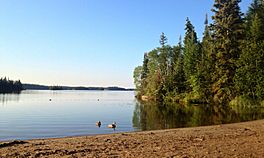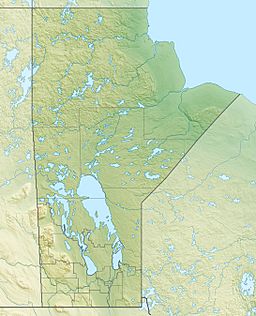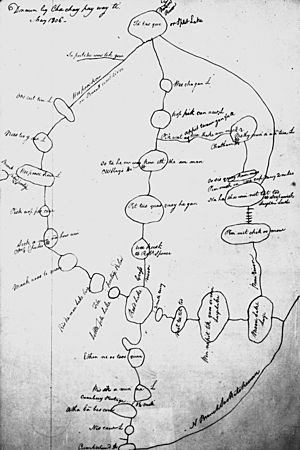Lake Athapapuskow facts for kids
Quick facts for kids Lake Athapapuskow |
|
|---|---|
| Lake Athapap | |

Lake Athapapuskow from the shore of the Bakers Narrows Campground looking southeast
|
|
| Location | Manitoba, Saskatchewan |
| Coordinates | 54°33′N 101°40′W / 54.550°N 101.667°W |
| Lake type | glacial lake |
| Native name | Athapa'puskow Saka'higan Error {{native name checker}}: parameter value is malformed (help) |
| Part of | Hudson Bay drainage basin |
| River sources | Pineroot River, Mistik Creek, Schist Creek, Flintoba Creek |
| Primary outflows | Goose River |
| Basin countries | Canada |
| Max. length | 31.2 km (19.4 mi) |
| Max. width | 35.2 km (21.9 mi) |
| Surface area | 269 km2 (104 sq mi) |
| Max. depth | 71 m (233 ft) |
| Shore length1 | 786 km (488 mi) |
| Surface elevation | 291 m (955 ft) |
| Frozen | November–May |
| Islands | + 575 |
| Settlements | Cranberry Portage, Bakers Narrows, Millwater |
| 1 Shore length is not a well-defined measure. | |
Lake Athapapuskow is a cool glacial lake in Canada! It's mostly in Manitoba, but a small part is in Saskatchewan. You can find it about 15 kilometers southeast of Flin Flon, Manitoba. This lake is part of a huge water system that eventually flows into Hudson Bay. It's also where the Goose River begins its journey.
Contents
Discover Lake Athapapuskow: A Glacial Gem
Lake Athapapuskow is made up of three connected parts. These are called "Big Athapap" in the south, "Little Athapap" in the middle, and the "North Arm." Most of the lake, about 267 square kilometers, is in Manitoba. Only a tiny bit, about 2 square kilometers, is in Saskatchewan.
Communities and Parks Around the Lake
There are three towns located right on the lake's shores. These are Cranberry Portage on the southeast side, Millwater on the north shore of "Big Athapap," and Bakers Narrows. Bakers Narrows sits between "Little Athapap" and the "North Arm."
The Flin Flon Airport is also found on the north shore of "Little Athapap." You can also visit Bakers Narrows Provincial Park here. It's a great place to explore the area between the North Arm and Little Athapap. Many fishing lodges are also located around the lake, making it a popular spot for visitors.
Nature and Wildlife at Lake Athapapuskow
The lake is surrounded by a special type of forest called a boreal forest. This is a mixed forest with both evergreen and leafy trees. It's part of the Canadian Shield, which is an ancient rocky area.
You'll find trees like black spruce, jack pine, white spruce, and trembling aspen here. The lake's water flows out through the Goose River, which is also known as the Rat River. This river is part of the larger Nelson River basin.
Amazing Fish and Fishing Records
Lake Athapapuskow is famous for its fishing! You can catch many different kinds of fish here. Some of them include walleye, yellow perch, northern pike, and lake trout. Other fish you might find are lake whitefish, burbot, rainbow trout, and white sucker.
The lake is known for its exciting sport fishing. It has even held three world records for fishing! In 1937, a person named Leone Grayson caught a world record Lake Trout near Gull Island. There's even a special stone marker at the Bakers Narrows Campground to remember this amazing catch.
Lake Athapapuskow's Rich History
People have lived in the Lake Athapapuskow area for a very long time. Scientists have found old pottery, arrowheads, and other tools at Bakers Narrows. These items are at least 2,500 years old! They show that people called the "Shield Archaic Culture" lived here regularly. They hunted caribou as far back as 7,000 years ago. Later, the Woodland Cree people, who were nomadic hunters, lived in this region.
Ancient Travel Routes and Explorers
The area around Cranberry Portage has been an important travel route for over 2,000 years. It connected the Grass River and Saskatchewan River watersheds. Many important Canadian explorers traveled through Lake Athapapuskow.
In 1763, Hudson's Bay Company explorers Joseph Smith and Isaac Batt were the first Europeans known to visit the lake. They were guided by a Cree leader named Meesinkeeshick. Later, in 1773, fur trader Joseph Hansom also explored the area.
In 1774, the famous explorer Samuel Hearne traveled through the lake. He was with six native guides and five canoes. They were carrying goods like tobacco, gunpowder, and brandy. Hearne was on his way to set up Cumberland House. This route became a very important part of the North American fur trade. It was known as the "Upper Tract."
Mapping the Lake and Modern Development
In 1794, another fur trader and mapmaker named David Thompson surveyed the lake. The lake first appeared on a map drawn by Peter Pond in 1785. He called it the "Middle Road to Hudson's Bay."
In 1806, explorer Peter Fidler recorded the waterways of his Cree partners. Lake Athapapuskow was clearly marked on his map. The lake was not fully mapped until 1914. This was when the Geological Survey of Canada sent Everend Bruce to do the work.
After valuable ore was found at Flin Flon, the lake became a key way to transport goods. During the First World War, ore from the Mandy Mine was moved across Lake Athapapuskow. It was carried on a boat called the S.S. Tonapah. From there, it went to The Pas by rail for processing.
In 1928, the Hudson Bay Railway reached Cranberry Portage. The town of Cranberry Portage was started in 1922. Manitoba Highway 10 reached Cranberry Portage in 1949. It was extended to Bakers Narrows in 1951. In 1961, Bakers Narrows Provincial Park was created on the lake.
The name "Athapapuskow" was officially registered in 1948. It comes from the Swampy Cree words "Athapa'puskow Saka'higan." This means "rock on both sides lake," which perfectly describes the lake's rocky shores.
Islands of Lake Athapapuskow
Lake Athapapuskow has more than 575 islands! Most of them don't have names. But some of the named islands include:
- Bakers Island
- Four Mile Island
- Gull Island
- Half Moon Island
- Hudson Bay Island
- Isabelle's Island
- Log Cabin Island
- See-Through Island
- Seven Mile Island
- Sewell's Island
- Steckler's Island
- Washing Machine Island
- Windmill Island




